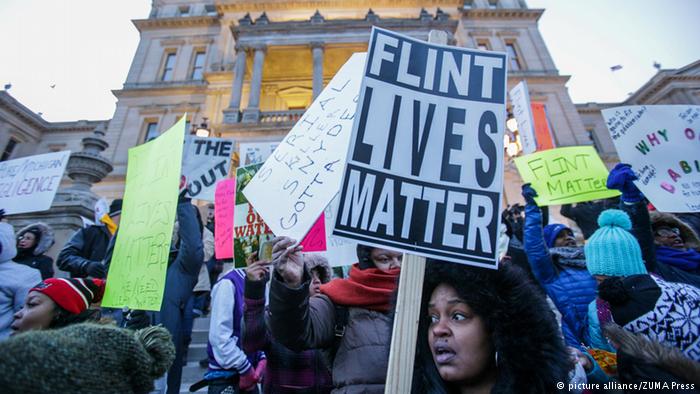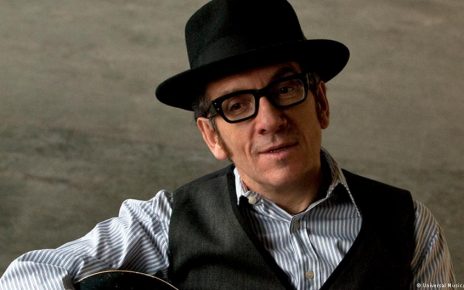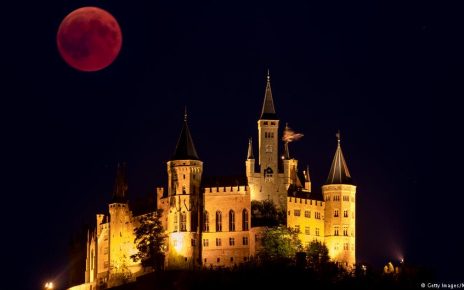“Tyrant. Liar. Racist. A Hole in One.”
So reads the provocative slogan on posters for Michael Moore’s latest film, Fahrenheit 11/9. The poster shows a golfer from behind, a man wearing a red baseball cap, his swing aiming for the White House. It’s clear who the image is meant to represent.
This movie is about Donald Trump — but not only him. Fahrenheit 11/9 deals with Trump’s election to the US presidency in 2016 and raises the question of how it could happen despite all polls suggesting otherwise. In his documentary, Moore also takes aim at the entire US political system.
Known for his controversial documentaries, Moore received an Oscar for Bowling for Columbine in 2003, a film about school shootings and the US arms industry.
In 2004 he was awarded the Palme d’Or at Cannes for Fahrenheit 9/11, which strongly criticized former US President George W. Bush’s “war on terror.”
‘Road was paved’ for Trump
The title of his latest, Fahrenheit 11/9, simply flipped the numbers to reference November 9, 2016, the date of Trump’s election victory and the beginning of a seismic shift in US politics.
For Moore, that day was just the culmination of a development long in the making.
“The film is also very much about who we are as Americans because [Trump] didn’t fall out of the sky,” Moore said on the red carpet at the Toronto International Film Festival earlier this month. “He’s been around for a long time and we’ve behaved a certain way for a long time that when you look back now you see how the road was paved for him.”
The US premiere took place on September 10 in Moore’s birthplace of Flint, Michigan. The city and its predominantly black citizens play an important role in the film. In recent years, it was discovered that residents had been supplied with lead-laced drinking water for more than two years due to budget cuts by Republican Governor Rick Snyder.
To save money, drinking water was drawn from a nearby river in 2014 rather than being piped in from Detroit. It was channeled through old pipes into the city, and the contaminated water combined with lead from the pipes resulted in residents becoming seriously ill. At least 10 people died of Legionnaires’ disease, likely caused by the contaminated river water, while others suffered from developmental delays as a consequence of the lead poisoning.

Flint has been dealing with a man-made, lead-tainted drinking water crisis since 2014
Ongoing crisis
For Moore, the scandal in Flint exemplifies what happens when a government decides that money and power are more important than people. In an interview after the Flint premiere, Moore said the victims must know their deaths weren’t in vain.
Several victims of the drinking water scandal were in the audience at the evening premiere. Their reactions to the film were emotional, as the Detroit Free Press observed. “At one point, when photos of Flint residents who died from Legionnaires’ disease during the water crisis were shown, one person yelled, “We love you all!,” the paper noted.
Ariana Hawk, the mother of a young boy who was a victim of the lead water crisis, told the daily The Detroit News that she hopes the film will bring the national spotlight back to Flint. “There are families here who still can’t drink the water, that are still affected by what the water did to them,” she said. “I know, I’m still living it.”
-
‘Fire and Fury’: A look inside Donald Trump’s White House
‘Fire and Fury’
Excerpts published by US and British news outlets from American journalist Michael Wolff’s new book “Fire and Fury: Inside the Trump White House” about US President Donald Trump’s administration have offered a look into the inner workings of the White House. From finding comfort in McDonald’s hamburgers to Ivanka’s presidential dreams, here are some excerpts from the book.
-
‘Fire and Fury’: A look inside Donald Trump’s White House
‘Melania was in tears’
“Shortly after 8 p.m. on Election Night, when the unexpected trend – Trump might actually win – seemed confirmed, Don Jr. told a friend that his father, or DJT, as he calls him, looked as if he had seen a ghost. Melania was in tears – and not of joy. There was, in the space of little more than an hour … a befuddled Trump morphing into a disbelieving Trump and then into a horrified Trump.”
-
‘Fire and Fury’: A look inside Donald Trump’s White House
Ivanka Trump the ‘first woman president’?
“Balancing risk against reward, both Jared (Kushner) and Ivanka decided to accept roles in the West Wing over the advice of almost everyone they knew … Between themselves, the two had made an earnest deal: If sometime in the future the opportunity arose, she’d be the one to run for president. The first woman president, Ivanka entertained, would not be Hillary Clinton; it would be Ivanka Trump.”
-
‘Fire and Fury’: A look inside Donald Trump’s White House
Finding comfort in fast food
“He had a longtime fear of being poisoned, one reason why he liked to eat at McDonald’s – nobody knew he was coming and the food was safely pre-made.”
-
‘Fire and Fury’: A look inside Donald Trump’s White House
Bannon’s theories
“The real enemy, (Bannon) said, was China. China was the first front in a new Cold War. China’s everything. Nothing else matters. We don’t get China right, we don’t get anything right. This whole thing is very simple. China is where Nazi Germany was in 1929 to 1930. The Chinese, like the Germans, are the most rational people in the world, until they’re not.”
-
‘Fire and Fury’: A look inside Donald Trump’s White House
Bannon: Donald Jr. was ‘treasonous’
“(Donald Trump Jr, Jared Kushner and campaign manager Paul Manafort) thought it was a good idea to meet with a foreign government inside Trump Tower in the conference room on the 25th floor – with no lawyers … Even if you thought that this was not treasonous, or unpatriotic, or bad shit, and I happen to think it’s all of that, you should have called the FBI immediately,” Bannon said.
-
‘Fire and Fury’: A look inside Donald Trump’s White House
‘Losing was winning’
“Once he lost, Trump would be both insanely famous and a martyr to Crooked Hillary. His daughter Ivanka and son-in-law Jared would be international celebrities. Steve Bannon would become the de facto head of the tea-party movement … Melania Trump, who had been assured by her husband that he wouldn’t become president, could return to inconspicuously lunching. Losing was winning.”
‘Generation of action’
At the film’s world premiere in Toronto on September 6, Moore appeared onstage with a number of guests, including survivors of the February shooting rampage at Marjory Stoneman Douglas High School in Parkland, Florida.
“After seeing this movie, after seeing everything on screen, and seeing the part that we played in this narrative, a lot needs to change, a lot needs to happen, and a lot just needs to get better,” said student Ryan Deitsch.
When an audience member called out that Deitsch’s generation could be labeled “the generation of hope,” Moore replied, “I’m against hope. What we need is the generation of action.”
Fahrenheit 11/9 is in theaters across the US and Canada as of September 21.
-
President Trump’s first year on magazine covers
The new statesman
This cover from the end of 2016 most likely pleased the newly elected US president. Time magazine picked Donald Trump as Person of the Year, a title that was also once given to Konrad Adenauer, John F. Kennedy and Martin Luther King — as well as Hitler and Stalin. The annual end-of-year feature picks someone who, “for better or for worse … has done the most to influence the events of the year.”
-
President Trump’s first year on magazine covers
With a Hitler mustache
Even before Trump’s election, the Mexican magazine Letras Libres made its opinion on Trump absolutely clear, using the words “American fascist” to form a Hitler mustache on his portrait. Building a wall on the US-Mexico border and clamping down on Mexican immigrants were some of Trump’s electoral promises.
-
President Trump’s first year on magazine covers
Walling in
Two weeks after Donald Trump’s election, the New Yorker creatively commented on the president’s border wall project. From subtle to explicitly insensitive depictions, international magazine covers featured a broad range of styles while commenting on Trump’s policies throughout the year.
-
President Trump’s first year on magazine covers
A rhetorical question
Renowned for its confrontational style, Charlie Hebdo also took on the newly elected US president. In a depiction referring to Trump’s infamous “grab women by the pussy” comments, the November 16, 2016, issue asked: “Did we have to entrust him with the nuclear button?”
-
President Trump’s first year on magazine covers
The prescience of the Simpsons
Donald Trump as US president: What was supposed to be a joke in The Simpsons turned out to be true 16 years later. British tabloid The Sun referred to the sitcom’s prophecy on its cover, showing Homer shocked by the turn of events, reacting with his catchphrase, “D’oh!”
-
President Trump’s first year on magazine covers
American psycho
The center-left French newspaper Libération reacted to the election with biting sarcasm. The headline was borrowed from a Bret Easton Ellis novel, “American Psycho.” Its narrator and main character, Patrick Bateman, is rich, superficial and narcissistic. There are numerous parallels to be drawn with the US president — but the fictional character is also a serial killer.
-
President Trump’s first year on magazine covers
Nothing to see here
Some commentators hoped Trump would soften the tone he used during his campaign once he took office. On this Time magazine cover, illustrator Tim O’Brien used fine paintbrush strokes to depict Trump’s chaotic first weeks in the White House.
-
President Trump’s first year on magazine covers
At the wheel
After Trump’s inauguration, the New Yorker commented on the childish behavior of the man who would from then on be steering the country. “Every so often, you hear stories on the news about a toddler who somehow manages to start the family car and drive the vehicle across town, where the law finally apprehends him,” said the artist behind the cover, Barry Blitt.
-
President Trump’s first year on magazine covers
An insurgent in the White House
The British weekly The Economist was inspired by Banksy’s famous artwork of a rioter throwing flowers for last February’s issue. It reacted to Trump’s first weeks in office, when he “lobbed the first Molotov cocktail of policies and executive orders against the capital’s brilliant-white porticos,” wrote the magazine’s editor, adding, “With Trump, chaos seems to be part of the plan.”
-
President Trump’s first year on magazine covers
Beheading freedom
A cartoon figure of Trump holding a bloodied knife and the Statue of Liberty’s head: The cover of German weekly Der Spiegel made headlines worldwide. It reacted to Trump’s “America First” policy and his threats to democracy, including his executive order to bar people from seven Muslim-majority countries from entering the country. The cover divided opinions within the country and abroad.
-
President Trump’s first year on magazine covers
Take your kids to work every day
It’s both a challenge and a goldmine for satirists: Trump’s politics and habits are often more bizarre than satire itself. On this cover, Mad magazine commented on the White House role given to the president’s daughter Ivanka and to his son-in-law and presidential adviser, Jared Kushner, who was morphed into the traits of the magazine’s iconic mascot, Alfred E. Neuman.
-
President Trump’s first year on magazine covers
The mouthpiece of white supremacists
After a far-right rally in Charlottesville, Virginia, a participant drove his car into a crowd of counter-protesters, killing a woman and injuring 19 people. Trump then declared that there were “very fine people” marching with the white supremacists that day, a comment which drew praise from former Grand Wizard of the Ku Klux Klan David Duke. The Economist reacted with this cover.
-
President Trump’s first year on magazine covers
Tailwind from the president
Following the Charlottesville rally events, The New Yorker also took aim at Trump’s remarks equating neo-Nazis and the Ku Klux Klan to the counter-protesters. “President Trump’s weak pushback to hate groups — as if he was trying not to alienate them as voters — compelled me to take up my pen,” said artist David Plunkert of his cover, entitled “Blowhard.”
-
President Trump’s first year on magazine covers
Breaking a taboo: a Hitler comparison
The German weekly Stern went one step further by unsubtly portraying Trump draped in the American flag and giving a Nazi salute. The cover story was headlined “Sein Kampf,” (His Struggle), a play on Adolf Hitler’s infamous “Mein Kampf” book. It drew sharp criticism from the Central Council of Jews for belittling Hitler’s crimes. Misappropriating Nazi symbols is taboo in Germany.
-
President Trump’s first year on magazine covers
Lazy boy
In early August, Newsweek magazine depicted Trump as a fast food-eating, bored TV junkie — descriptions also found in the book “Fire and Fury.” Headlined “LAZY BOY: Donald Trump is bored and tired. Imagine how bad he’d feel if he did any work,” the issue also pointed out that during his six months in office, he had spent 40 days at golf clubs, but had seen zero pieces of major legislation passed.
-
President Trump’s first year on magazine covers
A prominent phony
Trump likes to describe any media criticizing him as ” fake news,” but he’s also renowned for his own twisting of the truth. This fake Time magazine cover praising Trump’s TV show “The Apprentice” in 2009 was framed and on prominent display in at least five of his golf clubs. When the story came out last June, it felt like the perfect embodiment of Trump’s narcissism and lies.
-
President Trump’s first year on magazine covers
Russian bride of the year
Twitter went wild after the fake Time magazine cover story came out. Thousands of memes poking fun at Trump were created using the magazine’s iconic template. This one photoshopped the Person of the Year issue to turn Donald Trump into the “Russian bride of the Year,” commenting on Trump’s questionable Russian ties.
Author: Torsten Landsberg (eg)































